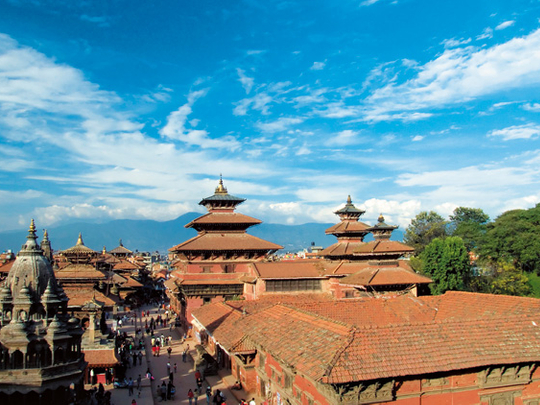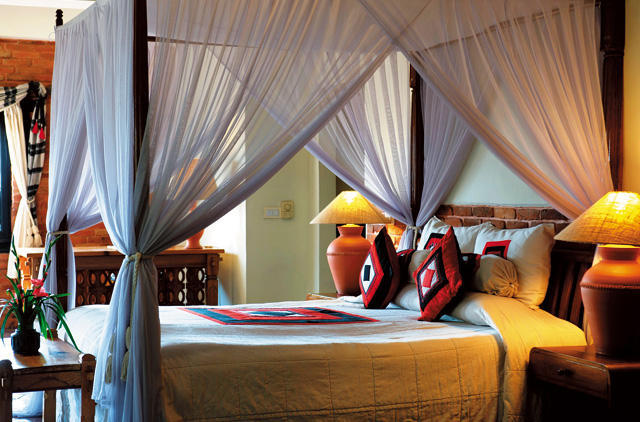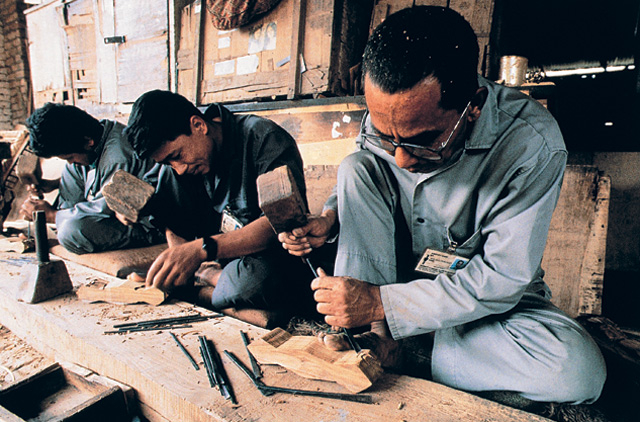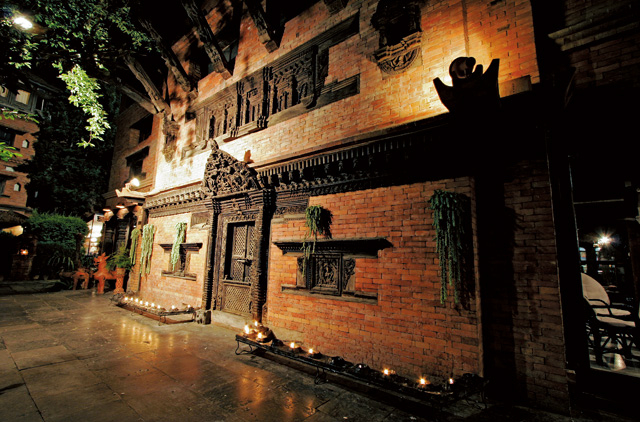
As I gazed up at the intricately carved window frame, amazed at the richness of detail in the ageing woodwork, a timid face suddenly peeped out to withdraw the colourful line of washing fluttering just underneath. That little everydayact of domesticity reminded me thatI wasn't staring at a museum exhibit, and this was in fact an actual window in a house people lived in. The window belonged to a historic building in Patan (pronounced Paa-tun), a heritage district in Kathmandu, and was one of many such exquisitely carved works of art that make up the traditional Newari architecture of Nepal.
History oozes from every single square inch of Patan, whether it's in the crumbling buildings, narrow cobbled alleys or the ancient temples, but it is history that is fast disappearing with neglect and disrepair. The skilful artistry juts out incongruously from the dilapidated buildings, stray dogs and garbage jostle for space in the alleyways, and historic monuments cry out fora good sweep.
History comes alive
Seeing the rich heritage of his country fall to such neglect, back in 1952, one conscientious local, Dwarika Das Shrestha, made it his personal mission to try and preserve as much of the Newari cultural legacy as possible. What started as an impulsive rescue of an engraved wooden pillar that was being sawn off as firewood, soon turned into a lifelong campaign to find and restore Kathmandu's traditional Newari handicrafts such as woodcarvings, sculptures, pillars and pottery.
He set up a workshop using local craftsmen to restore these magnificent pieces to their original glory and over time, as a way to sustain the project, opened up a small guest house in his family home to tourists. Realising that the best way to showcase his collection was in their original context, he then set upon building a hotel using traditional Newari brickwork in which the doors, windows, pillars and lintels could be put to use - an aesthetic and functional win. The project evolved over the years to become what is today a Kathmandu landmark, the Dwarika's Hotel.
A collection of traditional exposed red brick buildings around a sprawling courtyard bring the restored artifacts to life, in an elegant boutique hotel environment. As soon as you enter the premises, an old-world charm envelops you, a combination perhaps of the carefully preserved heritage and the genuinely warm hospitality. From the richly carved teak doors and windows, to terracotta figurines and bronze sculptures adorning the interiors, the attention to detail is mind-boggling.An effort has clearly been made to make you feel like you are being welcomed into the luxurious home of a wealthy host, starting with the scarf that is draped around your neck as you enter.
Every room is decorated ina distinctive fashion, incorporatinglocal elements as much as possible, whether it's the bathroom soaps made using Himalayan ingredients, or the traditional ‘Goat and Tiger' brass board game provided in each room (See Don't miss: Shop). Intimate and welcoming, the family-run Dwarika's Hotel is a relaxing sanctuary away from the rough and tumble of the city, a place where you can get a first-hand experience of Newari heritage while enjoying five-star luxury.
Where it all began
The Newari heritage the hotel pays tribute to dates back to the 12th century. A wealthy society - thanks to the fertile land and location on a profitable trade route between India and Tibet - ledto a flourishing artistic and cultural tradition. The Malla kings, as they were known, strongly encouraged the arts, traces of which are evident in over 2,500 temples that are dotted around Kathmandu Valley, making up as many as seven Unesco world heritage sites in this one region.
What is widely recognised as Kathmandu city today is divided into three main districts - based on three kingdoms that developed in the valley around the 15th century - Kathmandu, Bhaktapur and Patan, also known as Lalitpur. Each of these settlements had a Durbar square, which is the main hub of historical tourist attractions, with temples, shrines, elaborate residences, stupas (domed Buddhist monuments), and sunken water fountains fanning out from a central courtyard. Newari artisans are widely credited with giving the world the multi-tiered pagoda style of architecture, which has since gained popularity in Indo-China and the rest of Asia.
Newari culture was not only abundant in architectural creativity, but also very high skill levels in painting and sculpture, with the use of advanced techniques such as lost-wax casting (cire perdue) and repoussé. Most of Newari art and architecture is driven by religious iconography and symbolism; the local practice is a combination of Hinduism and Buddhism. In fact, the food, dance and music is all religious in nature, with the traditional calendar being full of colourful festivals marked by pomp, pageantry - a typical sign of a wealthy people - and elaborate feasts. A glimpse into this ceremonial feasting is offered at the Krishnarpan restaurant at Dwarika's Hotel (see Don't miss: Food).
To actually see what remains of the Newari culture in an urbanised environment, head to Patan and Bhaktapur; Kathmandu city is probably the most modernised part of the Kathmandu valley, where very few traces of Newar remain - think busy, congested streets and modern buildings. The Darbar Square in Patan has a ticketed entrance (around Dh10; Dh1.25 for Indian nationals) and inside, you will find a museum with historic memorabilia on display, aside from said temples (only Hindus are allowed inside), monasteries and homes, all featuring stunning relief work on their facades.
Have a wander around to soak up the vibe, then head to one of the rooftop cafés to chill out, sampling Nepalese delicacies like momos, while taking in the views of a city where past and present collide and coexist like nowhere else.
Bhaktapur, the third royal city, seems to take you further back in time witha larger expanse of historical monuments, including the 55-window palace which is home to the National art gallery, and many more temples. Life here moves ata slower pace.
With your history dose sorted, keep an afternoon aside to explore Thamel, the city-centre of Kathmandu, which is a bustling warren of narrow streets, souvenir shops, and atmospheric bars and cafés. It is a very touristy area, buta must-do in the city.
While a lot of the valley's history has sadly not been preserved, there seems to be a new wave of enthusiasm to research and rehabilitate Newah's unique traditions - with community-centric organisations such as the Dwarika's Hotel being at the forefront. Instead of just treating Kathmandu as a gateway to a trekking or river-rafting adventure, take a couple of days to discover the city's heritage - it will be an eye-opening experience. And if you've got onlya couple of days to spare, this makes for the perfect long-weekend escape.
Don't miss…
Food: Make a date for a gourmet meal at Krishnarpan restaurant at Dwarika's Hotel to enjoy a traditional Nepali feast. Hostesses in glittering bright saris and the ornate décor, complete with low floor seating, sets the tone for a royal culinary experience. A meal here starts from a minimum of six courses, going up to 22 if you wanted to truly spoil yourself. The food consists mainly of delicious curries with a focus on fresh, local produce, Himalayan herbs and home-style cooking. Little touches like personalised menus for each diner, and small terracotta brick souvenirs to take home make this dining experience stand out from others. From Dh140 per person for a six-course meal.
Shopping: Souvenir options are varied, from decorative wall hangings and photo frames featuring Newari woodwork, to Buddhist memorabilia such as prayer wheels and flags. Brass artefacts are plentiful, as are woollens, pashminas and cashmere scarfs. The local art is also beautiful, whether it's the Buddhist thangka art or devotional paubha paintings. Most of these can be found in Thamel's shops, where bargaining is a must. Souvenirs shops are also found in Patan and Bhaktapur and near the temples you can pick up colourful beads that women wear as traditional symbols of marriage, which make for trendy accessories.
Nightlife: Thamel, the backpackers' quarter of Kathmandu, is also where you will find most of the bars, pubs and cafés. But be warned - everything shuts quite early here. We loved Jatra, a cosy little café in Thamel which is equally popular with trendy youngsters and tourists alike. Jhamsikhel in Patan is another trendy area with loads of bars and pubs, where Kathmandu's expats like to hang out.
Mountain hideaway
For an easy escape into the country, head to Dhulikhel, an hour's drive from Kathmandu and one of the few remaining Newari enclaves dotted around Nepal. At the Dwarika's Himalayan Shangri La Village Resort, set on a densely forested mountain slope, you can enjoy incomparable views of the Himalayas right from your bedside along with the friendly local hospitality. Oversized windows looking out on to a green canopy with snow-capped mountains in the background, against the soundtrack of crickets, provide all the entertainment you will need here. Walking, hiking and mountain biking trails are in abundance in the area, and for those more adventure-inclined, activities like kayaking and white water rafting are also available. Plans are afoot to turn the resort into a sustainable spa village, with the renovated property due to reopen in January 2012. Room rates start from around Dh700. Visit www.dwarikashimalayanshangrila.com for more.
Need to know
Getting there: FlyDubai offers convenient direct flights to Kathmandu from Dubai, getting you there in just four hours. Flights leave Dubai in the early morning, returning from Kathmandu in the evening, and an array of food and entertainment is offered for sale in-flight, making this a comfortable option for a quick weekend getaway. Ticket prices start from Dh475 (one way) - visit www.flydubai.com
Staying there: Dwarika's Hotel offers accommodation in 88 luxurious rooms and suites, with facilities such as three speciality restaurants including Japanese fine-dining and traditional Nepalese, plus a lively nautical-themed bar. The hotel is also home to the luxe Pancha Kosha spa, offering treatments incorporating Himalayan herbs and signature techniques, and a gift shop stocking a range of local handicraft products. Room rates start from Dh1,027; visit www.dwarikas.com







